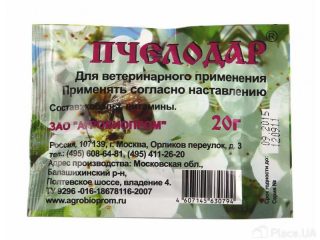Content
Akarasan belongs to specialized highly effective insecticides aimed at killing mites, called acaricides. Its action has a narrow specialization and allows you to destroy varroa mites (Varroajacobsoni), as well as Acarapiswoodi, which parasitize domestic honey bees. The article provides instructions for the use of Akarasan for bees and indicates the features of using the drug.
Application of the drug in beekeeping
Akarasan is created for use in home and industrial beekeeping to prevent the following diseases of bee colonies:
- acarapidosis;
- varroa.
Composition, release form
The Akarasan dose contains two components:
- fluvalinate – 20 mg;
- potassium nitrate – 20 mg.
Akarasan is a means of fumigation.That is, the smoke from the combustion products of the drug has medicinal properties. For ease of use, Akarasan is produced in the form of strips of cardboard measuring 10 cm by 2 cm with a thickness of 1 mm.
The strips are folded in groups of 10 in sealed foil packages with three-layer walls.
Pharmacological properties
The active ingredient of Akarasan - fluvalinate, which is a derivative of the racemate, is a powerful remedy against small ticks. It has proven itself well in the fight against varroa and acarpis mites. The acaricidal effect of fluvalinate is best manifested as an airborne suspension in the air or as a vapor.
When using the drug, the base of the strips is set on fire, it begins to smolder, which leads to the evaporation of fluvalinate and its air contact with the mites located on the bees in the hive. It is enough for a bee to stay in a hive filled with fluvalinate vapor for about 20-30 minutes for the mites to receive a lethal dose of the drug.
Instructions for use of Akarasan strips
Strips of the drug are fixed on empty nesting frames and set on fire, after which they are immediately extinguished, and the frames with smoldering plates are installed in the hive.
The hive entrances are closed and opened after an hour, removing the burnt strips. If the Akarasan strip does not burn completely, repeat the treatment after an hour. In this case, use a whole strip or half of it.
Dosage, rules of use
According to the instructions, the dosage of Akarasan is one strip per 9 or 10 hundred frames.
The drug must be used in such a way that the majority of bees are in the hive. In addition, the bees must have water in the hive during the treatment.
When bees are affected by acarapidosis, treatment is done 6 times per season with a break of a week. The fight against varroa involves two treatments in the spring and two in the fall, one after the other every other week.
Contraindications and restrictions for use
If the dosage is observed, no side effects are observed.
However, there are restrictions on the use of Akarasan, depending on various circumstances:
- Treatment with Akarasan should be carried out only at air temperatures above + 10 °C.
- Processing of the bee colony should be carried out early in the morning or late in the evening.
- The procedure should not be used earlier than 5 days before honey collection.
- It is forbidden to process small families and small-sized hives (if the number of “streets” in the hive is less than three).
Akarasan belongs to substances of the fourth hazard class. It is not toxic and poses no danger to the human body.
Shelf life and storage conditions
Akarasan strips are stored in a cool and dark place at a temperature of + 5 ° C to + 20 ° C. The shelf life under such conditions is 24 months.
Conclusion
The instructions for using Akarasan for bees are quite simple, and the effectiveness of this drug on mites is high. By following the correct treatment schedule, you can be guaranteed to protect your apiary from the invasion of parasitic mites.
Reviews
Below are reviews on the use of Akarasan strips.










